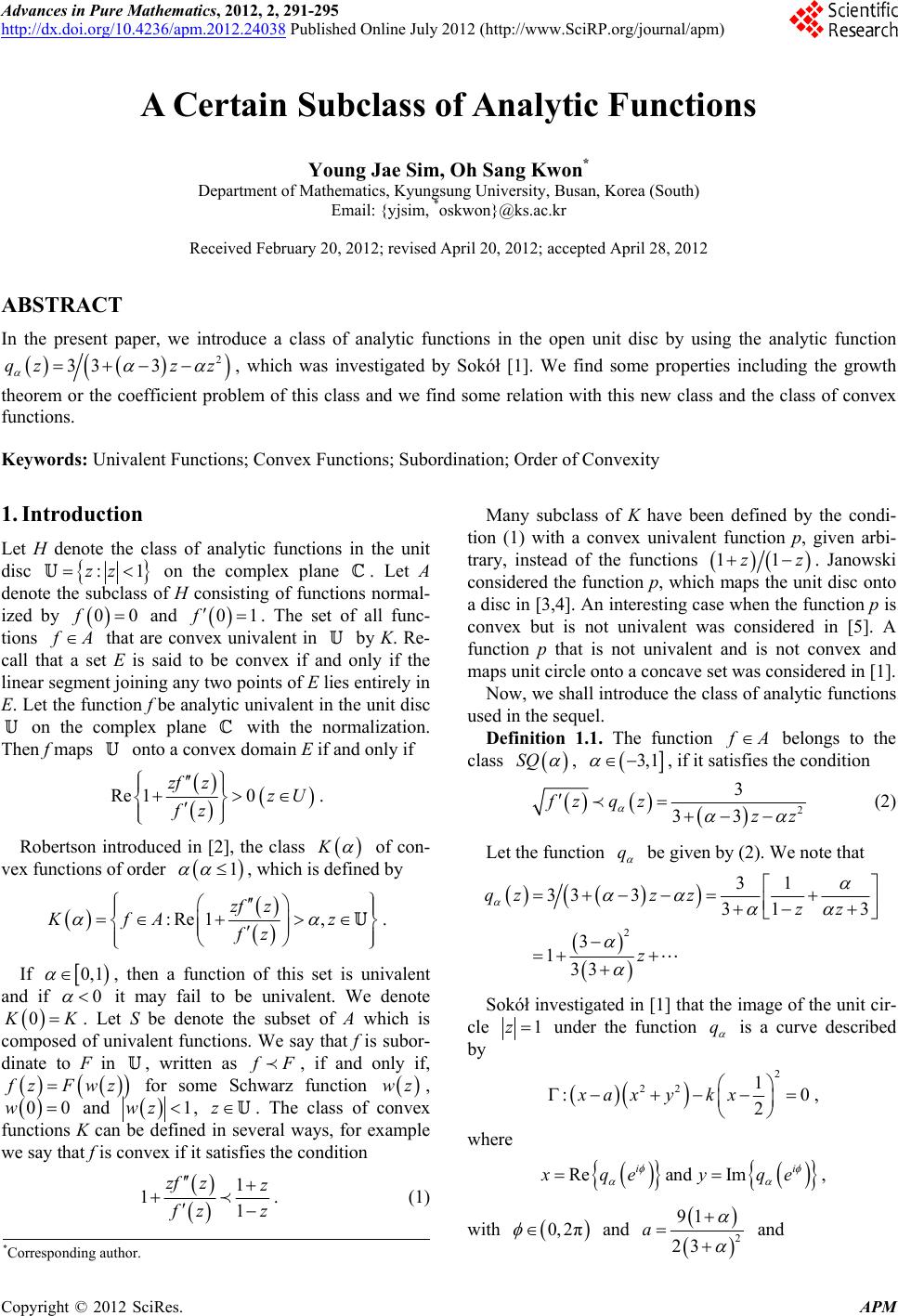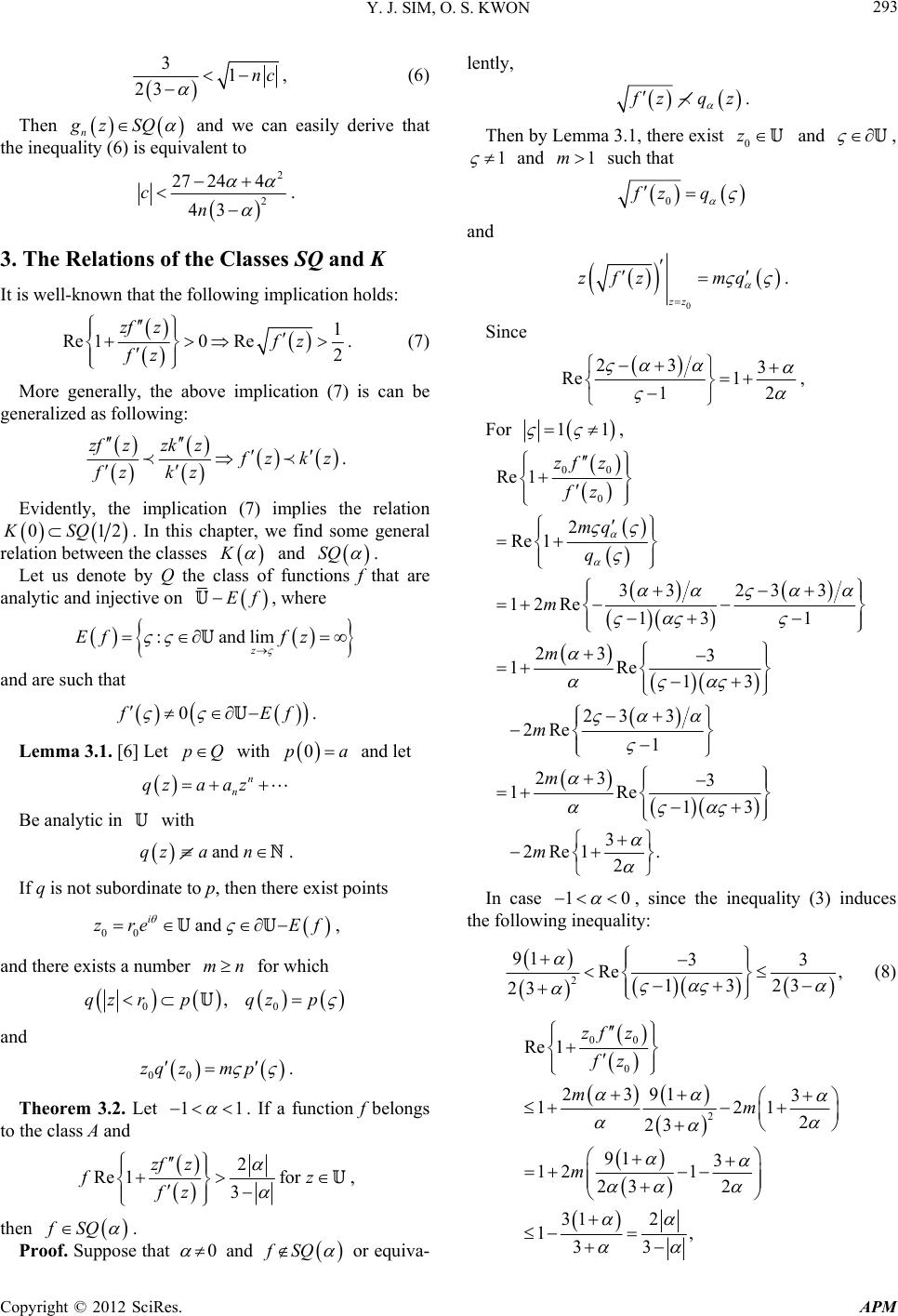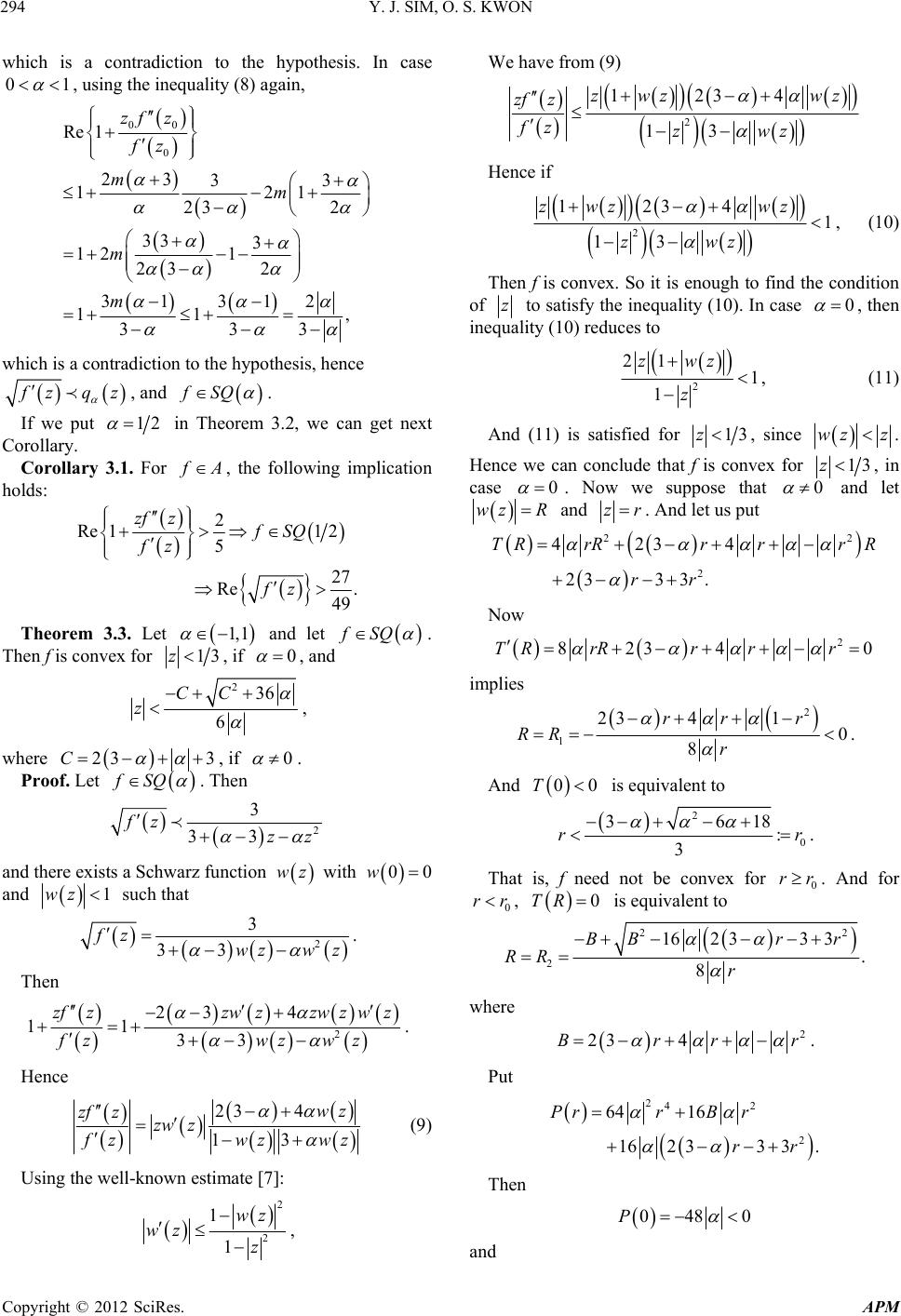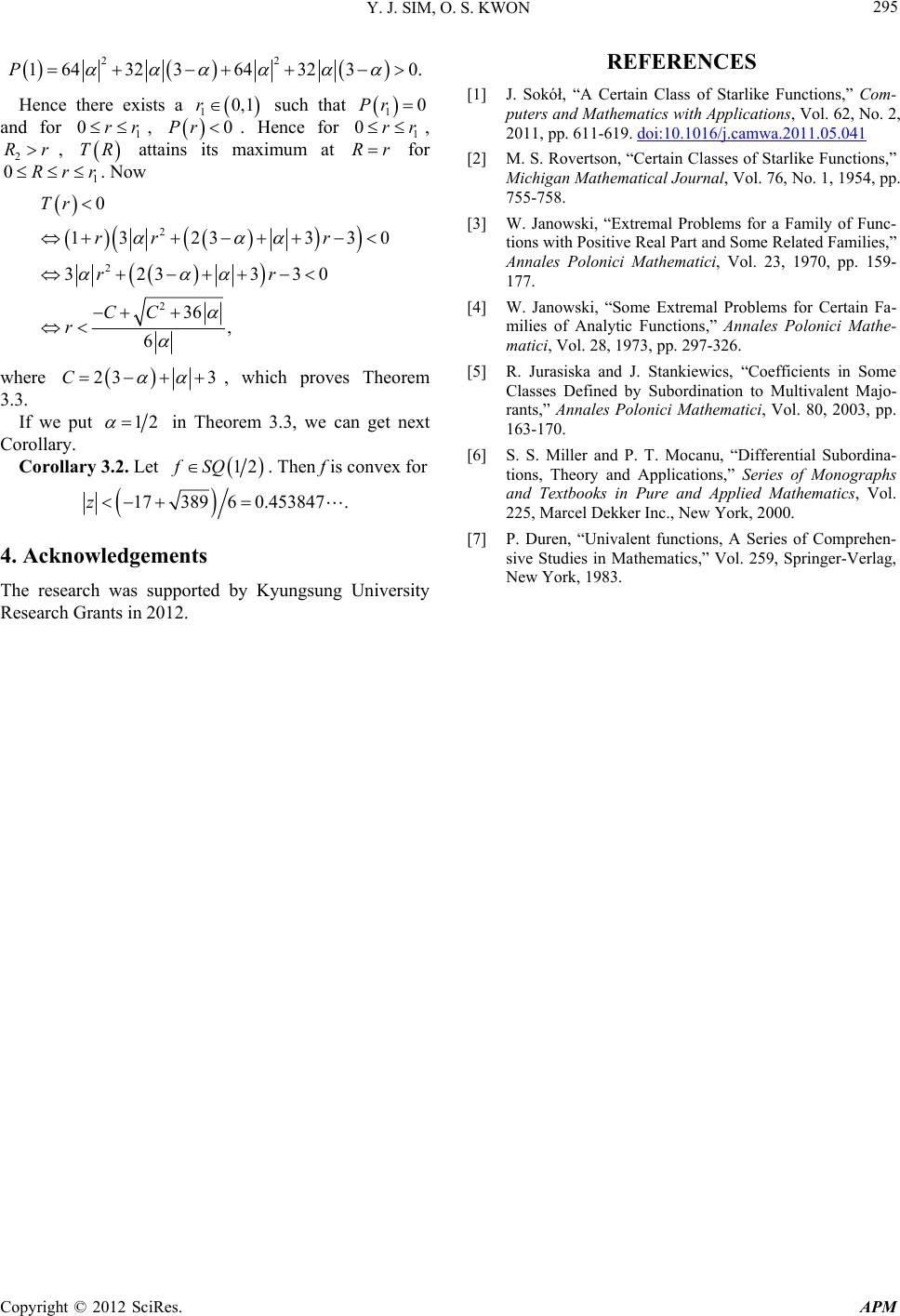 Advances in Pure Mathematics, 2012, 2, 291-295 http://dx.doi.org/10.4236/apm.2012.24038 Published Online July 2012 (http://www.SciRP.org/journal/apm) A Certain Subclass of Analytic Functions Young Jae Sim, Oh Sang Kwon* Department of Mathematics, Kyungsung University, Busan, Korea (South) Email: {yjsim, *oskwon}@ks.ac.kr Received February 20, 2012; revised April 20, 2012; accepted April 28, 2012 ABSTRACT In the present paper, we introduce a class of analytic functions in the open unit disc by using the analytic function 2 3z z 33qz , which was investigated by Sokół [1]. We find some properties including the growth theorem or the coefficient problem of this class and we find some relation with this new class and the class of convex functions. Keywords: Univalent Functions; Convex Functions; Subordination; Order of Convexity 1. Introduction Let H denote the class of analytic functions in the unit disc :1zz 0f on the complex plane . Let A denote the subclass of H consisting of functions normal- ized by and 00f1 . The set of all func- tions A that are convex univalent in by K. Re- call that a set E is said to be convex if and only if the linear segment joining any two points of E lies entirely in E. Let the function f be analytic univalent in the unit disc on the complex plane with the normalization. Then f maps onto a convex domain E if and only if 0zU K Re 1zf z fz . Robertson introduced in [2], the class of con- vex functions of order , which is defined by 1 :Re 1, z KfA z fz 0, 1 0 zf . If , then a function of this set is univalent and if 0 it may fail to be univalent. We denote K . Let S be denote the subset of A which is composed of univalent functions. We say that f is subor- dinate to F in , written as F , if and only if, zFwz for some Schwarz function wz , and 00w 1wz , z . The class of convex functions K can be defined in several ways, for example we say that f is convex if it satisfies the condition 1 1 zz 1zf zz . (1) Many subclass of K have been defined by the condi- tion (1) with a convex univalent function p, given arbi- trary, instead of the functions 11zz. Janowski considered the function p, which maps the unit disc onto a disc in [3,4]. An interesting case when the function p is convex but is not univalent was considered in [5]. A function p that is not univalent and is not convex and maps unit circle onto a concave set was considered in [1]. Now, we shall introduce the class of analytic functions used in the sequel. Definition 1.1. The function A belongs to the class SQ , 3,1 , if it satisfies the condition 2 3 33 fz qzzz q (2) Let the function be given by (2). We note that 2 31 33 331 3 3 133 qzz zzz z Sokół investigated in [1] that the image of the unit cir- cle 1z q under the function is a curve described by 2 22 1 :0 2 xax ykx , where Reand Im ii xqe yqe , with 0, 2π and 2 91 23 a and *Corresponding author. C opyright © 2012 SciRes. APM  Y. J. SIM, O. S. KWON 292 2 54 33 k i qe . Thus the curve is symmetric with respect to real axis and satisfies 2 91 Re 23 i qe 3, 23 0, 2π (3) where . Especially, if 0 , then 0 qz , which maps onto the right of line 11 z 12x 21 31 . And we note that if 12 qq , then . 2. Some Properties of Functions in SQ Now we shall find some properties of functions in the class SQ . Theorem 2.1. If a function f belongs to the class SQ , 3,1 , then there exists a function A such that 11 zz hA and a function such that 33 zhz and zgzhz SQ . Proof. Let f be in . Then there exists an ana- lytic function with wz 00w and 1wz for such that z 3 13wz fz wz . (4) From (4) we have 21 fz wz f zwz 3 wz wz . Define g and h so that 21 zwz zwz and 23 wz wz hz hz , respectively. Then 11 zz , 33 zhz and 222 zgzhz zgzhz . zgzhz Hence fSQ , which proves Theorem 2.1. Theorem 2.2. If , 3,1 and zr, 01r , then 2 2 2 2 1 11 3 1 11 3 fz rr rr fSQ (5) Proof. Suppose that . Then zgzhz For some g and h such that 11zz and 33hz z , respectively. And above subordination equations imply that 22 11 11 gz rr and 22 11 13 13 hz rr , respectively. Since zgzhz , the modulus of z satisfies the inequality (5). Next, we shall solve some coefficient problem for a special function to be in the class SQ . n n Theorem 2.3. The function zzcz belongs to the class SQ , whenever 2 2 27 244 43 cn . 1 1n nzncz , if we put Proof. Since n Gzgz , then 21 1n Gz ncz z . , Hence for 21Gz nc . Re 1Gz nc Since , if Copyright © 2012 SciRes. APM  Y. J. SIM, O. S. KWON 293 3 231nc gz SQ , (6) Then n and we can easily derive that the inequality (6) is equivalent to 2 2 24 4 43n 27 c . 3. The Relations o f the Classes SQ and K It is well-known that the following implication holds: 1 2 fz Re 10Re zf z fz . (7) More generally, the above implication (7) is can be generalized as following: zfzzk z zkz fz kz . Evidently, the implication (7) implies the relation 012KSQ. In this chapter, we find some general relation between the classes K and SQ . Let us denote by Q the class of functions f that are analytic and injective on Ef ndlimfz , where Ef :a z and are such that 0 Ef 0pa n p . Lemma 3.1. [6] Let with and let Q n a azqz Be analytic in with anda n Ef mn qz . If q is not subordinate to p, then there exist points 00 and i zre , and there exists a number for which ,qzrp 00 qz p m p and 00 zq z 11 . Theorem 3.2. Let . If a function f belongs to the class A and 2 Re 13 zf z fz forfz fSQ , then . Proof. Suppose that 0 and fSQ or equiva- lently, zqz 0 z . Then by Lemma 3.1, there exist and 1 , and m such that 1 0 fz q and 0 zz zfz mq . Since 23 3 Re 1 12 , For 11 , 00 0 Re 1 2 Re 1 33 233 12Re 13 1 23 3 1Re 13 233 2Re1 23 3 1Re 13 3 2Re12 zf z fz mq q m m m m m . 10 In case , since the inequality (3) induces the following inequality: 2 91 33 Re , 1323 23 (8) 00 0 2 Re 1 23913 121 2 23 91 3 12 1 23 2 231 1, 33 zf z fz mm m Copyright © 2012 SciRes. APM  Y. J. SIM, O. S. KWON 294 which is a contradiction to the hypothesis. In case 01 , using the inequality (8) again, 00 0 Re 1 23 12 23 33 3 121 23 313 11 33 zfz fz m m m 33 1 2 2 21, 3 m which is a contradiction to the hypothesis, hence zqz , and fSQ . If we put 12 in Theorem 3.2, we can get next Corollary. Corollary 3.1. For A, the following implication holds: 2 Re 15 Re zf z fz 1 2 27 . 49 fSQ fz Theorem 3.3. Let and let 1, 1 fSQ . Then f is convex for 13z, if 0 , and 236 6 CC z , where 23C3 0, if fSQ. Proof. Let . Then 2 3 33zz fz and there exists a Schwarz function wz with 00w and 1z s wuch that 2 3 33 fz wzw z . Then 2 4zw z wz w z 23 11 33 zf zzw z fz wz . Hence 23 zf zzw z fz wz 4 13 wz wz (9) Using the well-known estimate [7]: 2 2 1 1 wz z wz , We have from (9) 2 1234 13 zwz wz zf z fz zwz Hence if 2 1234 1 13 zwzwz zwz , (10) Then f is convex. So it is enough to find the condition of z0 to satisfy the inequality (10). In case , then inequality (10) reduces to 2 21 1 1 zwz z , (11) wz z And (11) is satisfied for 13z, since . Hence we can conclude that f is convex for 13z 0 , in case . Now we suppose that 0 and let wz R and zr. And let us put 22 2 4234 2333 . TRrRrrr R rr Now 2 82340TRrRr rr implies 2 1 2341 0 8 rr r RR r . 00T is equivalent to And 2 0 3618 : 3 rr 0 rr 0 rr . That is, f need not be convex for . And for 0TR , is equivalent to 22 2 162333 8 BBr r RR r . where 2 23 4Brrr . Put 242 2 64 16 162333. PrrBr rr Then 048 0P and Copyright © 2012 SciRes. APM  Y. J. SIM, O. S. KWON Copyright © 2012 SciRes. APM 295 REFERENCES 3 0. 22 1 643236432P [1] J. Sokół, “A Certain Class of Starlike Functions,” Com- puters and Mathematics with Applications, Vol. 62, No. 2, 2011, pp. 611-619. doi:10.1016/j.camwa.2011.05.041 1 10Pr 10,r such that Hence there exists a and for 1 0, . Hence for 1 rr 0Pr0rr Rr , , attains its maximum at 2 Rr TR for . Now 1 r0Rr 2 2 2 0 13 23 323 3 36 , 6 Tr rr rr CC r [2] M. S. Rovertson, “Certain Classes of Starlike Functions,” Michigan Mathematical Journal, Vol. 76, No. 1, 1954, pp. 755-758. [3] W. Janowski, “Extremal Problems for a Family of Func- tions with Positive Real Part and Some Related Families,” Annales Polonici Mathematici, Vol. 23, 1970, pp. 159- 177. 330 30 r [4] W. Janowski, “Some Extremal Problems for Certain Fa- milies of Analytic Functions,” Annales Polonici Mathe- matici, Vol. 28, 1973, pp. 297-326. [5] R. Jurasiska and J. Stankiewics, “Coefficients in Some Classes Defined by Subordination to Multivalent Majo- rants,” Annales Polonici Mathematici, Vol. 80, 2003, pp. 163-170. where 23C3 , which proves Theorem 3.3. If we put 12 in Theorem 3.3, we can get next Corollary. [6] S. S. Miller and P. T. Mocanu, “Differential Subordina- tions, Theory and Applications,” Series of Monographs and Textbooks in Pure and Applied Mathematics, Vol. 225, Marcel Dekker Inc., New York, 2000. Corollary 3.2. Let 12fSQ. Then f is convex for 173896z 0.453847 . [7] P. Duren, “Univalent functions, A Series of Comprehen- sive Studies in Mathematics,” Vol. 259, Springer-Verlag, New York, 1983. 4. Acknowledgements The research was supported by Kyungsung University Research Grants in 2012.
|